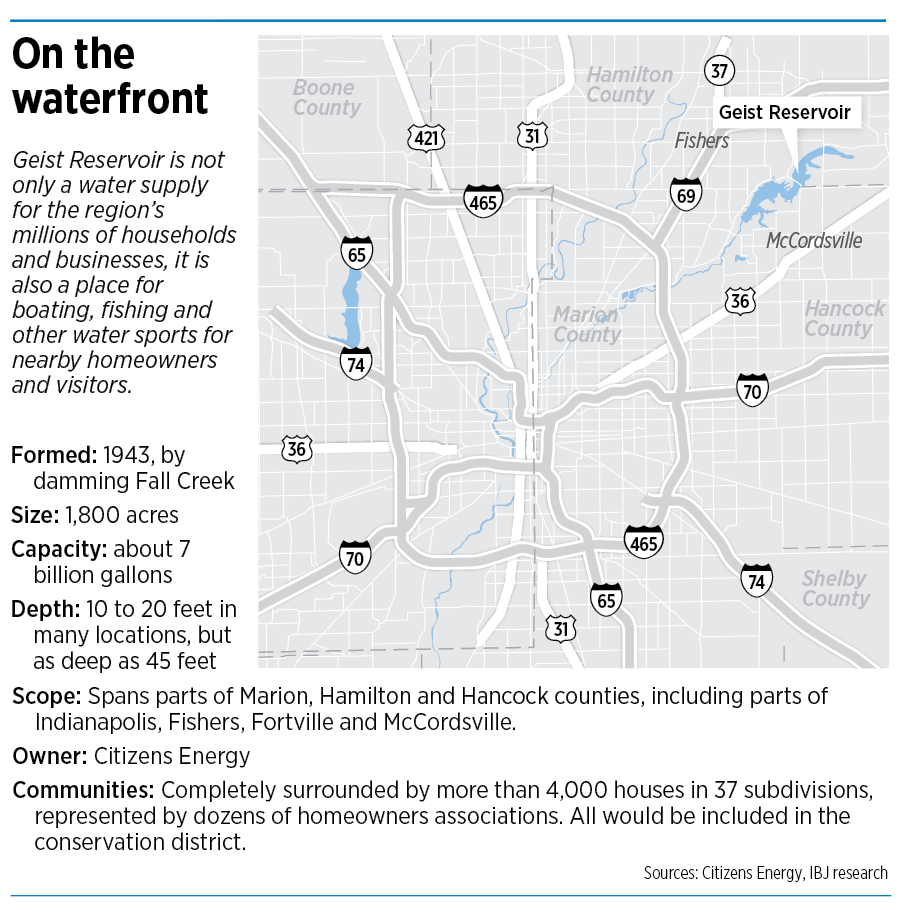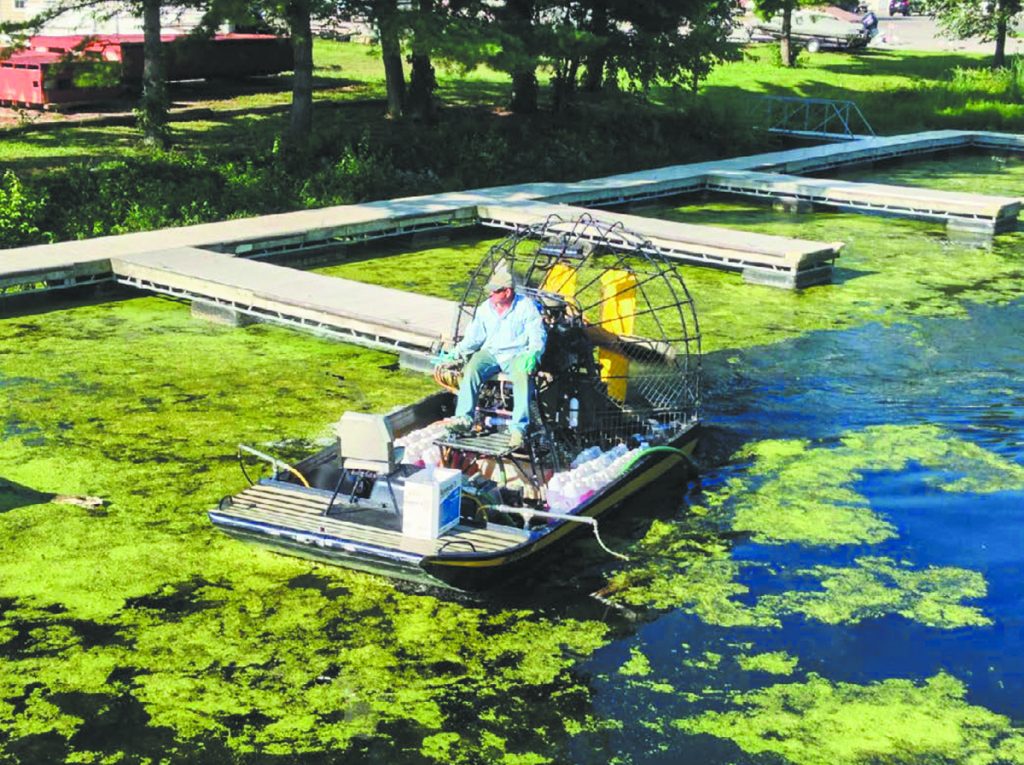Subscriber Benefit
As a subscriber you can listen to articles at work, in the car, or while you work out. Subscribe NowOn some days, the seaweed and algae on Geist Reservoir and its inlets grow so thick that some residents wonder if they should swim in the lake or just walk on it.
“It’s awful,” said Matt Troyer, an attorney who has lived for 13 years in a cove on the east side of the reservoir. “It appears as though you could walk across the cove with all the weed growth and algae and everything else.”
More than 1,400 Geist households want the state to approve a special taxing district to raise millions of dollars annually to provide regular maintenance to the reservoir. Otherwise, they fear, the reservoir—which is only 10 to 12 feet deep in many areas—eventually will be overrun with silt and unusable for fishing, swimming and boating.

But other residents oppose that move. They say the taxes would benefit mostly lakefront property owners, not the people who live a few blocks away, without scenic waterfront views from their back decks and picture windows.
“In my particular neighborhood, there are homes that are a quarter-mile from the lake,” said John Domokos, a consultant who is a founding member of the Geist Reservoir Tax Opposition Alliance. “They don’t see it. They don’t smell it. They don’t drive by it. And they would pay the same tax rate as someone who is lakefront.”
The debate casts a glare on divisions in one of central Indiana’s wealthiest areas, where some waterfront mansions are worth more than $5 million. The area is home to the rich and famous, including athletes, business titans and celebrities.
But not all of the shoreline is equally tony. In some areas, especially on the south end, near the dam, some houses sell in the $300,000 range.
Nearly all of the shoreline is, however, private property—belonging to homeowners and boat clubs. In 2017, Fishers Mayor Scott Fadness announced plans to build a 70-acre public beach and park called The Cove, making it the only spot on the lake open to the public, aside from a few restaurants and a public boat launch. However, that project is years from completion.
The former Indianapolis Water Co. created Geist Reservoir in 1943 by damming Fall Creek, to provide drinking water for the city. In more recent decades, the 1,800-acre reservoir, now owned by Citizens Energy Corp., has been transformed from a sleepy water supply to a recreational mecca and upscale residential hot spot.
But in the process, it has become so overrun with weeds, algae and silt that many residential areas along its shoreline need to be dredged out every few years at a cost of hundreds of thousands of dollars, paid for by one of the area’s 40 homeowners associations.

Citizens Energy says it has spent $1.2 million since 2015 on dredging in the reservoir to remove sediment and maintain storage capacity. But it says it does not dredge for recreational purposes, which forces residents to deal with thick seaweed and growing amounts of sediment along residential boat docks, neighborhood coves and in boating channels.
It said it has the same policy along Morse Reservoir in northern Hamilton County, which is popular for its beaches and boating.
“Citizens does not manage the reservoirs for recreational or aesthetic purposes,” company spokesman Dan Considine said.
‘Nature takes back over’
Since residential development began in the 1980s, 37 developments with about 4,000 houses have sprung up around the reservoir, spanning parts of three counties—Marion, Hamilton and Hancock.
Much of the reservoir’s incoming sediment flows in from those adjoining residential areas and from the up-basin corn belt. Dirt from farms and developments has emptied in the streams and flowed down into Geist Reservoir.
“Like everything else that’s man-made, if you create a lake and then don’t do anything, eventually nature takes back over,” Troyer said.
For about two decades, the job of maintaining the reservoir has fallen to the all-volunteer Geist Lake Coalition. Over the years, members have gone door to door around the reservoir to ask for donations and sponsorships. In that way, they have raised and spent millions of dollars on various maintenance projects.
But now the coalition says the lake needs more help than can be done by a group of volunteers knocking on doors for $20 or $50 donations.
“Geist Reservoir is in dire need of dredging, as well as catch basins that can be cleaned out with a regular maintenance plan,” said Brian Hall, owner of Indianapolis-based Repro Graphix Inc. and the coalition’s president. He lives on the southeast side of the reservoir, across the street from the lake.

The coalition said the lack of stream bank remediation is causing shoreline instability, resulting in heavy sediment load. It also warns that invasive aquatic plants and species, such as Eurasian watermilfoil and zebra mussels, are destroying native species and clogging watercraft.
Geist Lake Coalition has formed what’s known as a conservancy district, or a special-taxing district that has the power to assess properties, and it’s now seeking government sanction.
It said the district would be funded through a combination of assessments and user fees on motorboats. The assessments would vary, costing $130 a year for the owner of a $350,000 house, and $412 for the owner of a $1 million house. The homeowners also would pay $125 a year for a watercraft permit fee.
The coalition estimates that the conservancy district, which would operate in perpetuity, would raise $2 million per year.
The Indiana Department of Natural Resources defines a conservancy district as a way for landowners to set up a taxing district to assist with water resource management. Statewide, there are more than 90 such districts, which work to control floods, sewage and pollution.
The Geist Conservancy District would encompass all the developments that abut the waterfront—and in some places, extend several blocks back from the water.
Over the past 18 months, the coalition has gathered 1,453 signatures (each household is limited to one signer)—representing nearly 40% of the households in the district. That is higher than the 15% required by state law.
Next steps

In November, the coalition submitted the signatures and petition to Hamilton County Court. If the court validates the signatures, it will send the petition to the Natural Resources Commission for hearings and findings of facts on the feasibility of a conservancy district.
The petitioners will have to prove that the benefits of the proposed conservancy district—solving or lessening the problems in the lake for recreation—will outweigh the costs.
If the commission agrees, a board of elected officials from the conservancy district—which would operate much like a town council, elected by members of the district—would govern the finances and the projects.
But the plan already has hit a snag. Citizens Energy asked the coalition to join forces with it to change part of the state law concerning conservancy districts, including a portion that gives conservancy districts eminent domain—the power to expropriate private property for other uses.
The utility said it was concerned that a conservancy district could interfere with its operational rights at the reservoir, and thus its ability to provide water to customers.
The coalition said it wants the conservancy district to keep the powers of eminent domain to allow it to install and clean out catch basins, among other reasons. But it agreed to exempt Citizens from the provision, and lined up Sen. Jim Merritt, R-Indianapolis, to introduce a bill.
In a hearing last month before the Senate Environmental Committee, Merritt argued the coalition had gathered widespread support.
“People understand that the condition of the lake, the caring of the lake—even if you don’t have lakefront property—is important for property values,” Merritt said.
The coalition has said 75% of the signatures it has collected in the district are from people who don’t own lakefront property.
Several homeowners testified that the reservoir needed substantial help, and that the conservancy district was the best way to provide it.
“A volunteer organization has put a Band-Aid on this lake for a long time,” said resident Cory Peter, president of Pendleton-based 101 Inc., which turns food byproducts into other uses, such as livestock feed and biofuels.
Carol Murphy, past president of the ShoreWalk Homeowners Association, near the south side of the reservoir, said her association spent hundreds of thousands of dollars to do a complete dredging of their cove in 2005, and thought it would take care of the problem for 20 years.
“In 2009, we were back to the same level of silt,” she said.
‘It’s reckless’
 The Indianapolis Yacht Club, which has 103 boat docks, said it has donated $2,000 to $5,000 a year to the Geist Lake Coalition. It now supports the conservancy district but initially opposed it—in part because it would face no cap on the amount it could collect from homeowners and would be free to set any rate.
The Indianapolis Yacht Club, which has 103 boat docks, said it has donated $2,000 to $5,000 a year to the Geist Lake Coalition. It now supports the conservancy district but initially opposed it—in part because it would face no cap on the amount it could collect from homeowners and would be free to set any rate.
“We can’t go from giving $5,000 a year, which we can absolutely afford, to $20,000 a year,” said Lori Stadick, the club’s commodore, or CEO. “It’s reckless.”
Domokos of the Geist Reservoir Tax Opposition Alliance said a large percentage of people in the district are not interested in boating or swimming and oppose uncapped taxes.
He would not say how many property owners had signed petitions in opposition. To block a conservancy district, opponents have to get signatures from 51% of them.
Coalition leaders say opponents are missing the bigger picture.
They say the reservoir is in danger of tipping into the toxic zone, due to the buildup of blue-green algae, a bacteria that is coating large parts of the lake and can cause disease in humans and other animals.
“It’s short-sighted, because their property will be impacted if the reservoir goes toxic,” Hall said. “If it was to go toxic, it would affect those off the water, blocks away and maybe even half a mile away.”
They say that dire scenario has occurred at other reservoirs, including Grand Lake in St. Marys, Ohio, which was overcome with blue-green algae blooms and was forced to close to recreational use from 2010 to 2013. Cleanup efforts there have cost more than $150 million.
Some Indiana senators say they’re convinced Geist Reservoir needs the lifeline a conservancy district would provide.
“Geist Lake is a tremendous asset to this area,” said Sen. Andy Zay, R-Huntington. “I would hate for it to continue to fall behind.”
The Senate Environmental Committee voted 7-4 last month to advance the bill. But once it got to the Senate floor, it was amended to remove the proposed district’s power of eminent domain and to limit the amount it could raise annually to $2 million a year. The Senate passed the amended bill, 46-2.
The House Environmental Committee on Feb. 18 unanimously passed the bill, advancing it to the full House for a vote.•
Please enable JavaScript to view this content.


I suggest every metro Indiana resident review the Clear Choices Clean Water Program on the White River Alliance website. Not only is sediment from construction and agriculture being carried into Geist Reservoir, so are nutrients from grass clippings, unneeded lawn treatments and animal waste from homes. We are all contributing is some way to nutrient load in our waters. Let’s avoid toxic conditions like those affecting drinking water in Toledo, Ohio and Grand Lake of St. Mary’s.
Mary. What do you think about all those boats tied together for hours at a time. The boats don’t have restrooms, people just jump into the water and relieve themselves. It’s not just fish fouling the water. More restrooms would be a solution.
Well, Mary B, I have a suggestion for you – when you’re trying to direct people somewhere, it’s been my experience it’s a little easier for them to to that if you take the time to give them the link, they only have to click on it. So I did it for you: https://thewhiteriveralliance.org/wp-content/uploads/2018/03/CCCW_Flipsnack_Guidance-Document.pdf
Geist residents are largely to blame for the algae growth. Lawns are heavily fertilized and many properties slope toward the water. They missed a great opportunity 5 or 6 years ago when during the drought exposed many of the inlet floors where many are quite shallow and should have been dug deeper. Algae harvesting machines have been used for several years on the downtown canal and on the canal along Broad Ripple, have been successful, but one has to keep at it for the long run. Since Geist is an important water supply for Indianapolis, the water company should chip in to clear this stuff out before it poisons the water. Look at northern Ohio, where Lake Erie, (which has a an average depth of 210 feet, closer to the shore, one can walk 50 feet out into the water before you are submerged. The algae has ruined their lake experience and generally becomes a health problem at some point in the summer. Putting a tax on residents is fine, but will all of the revenue go to solving this problem.
Lawn chemicals have major impacts on lakes. Toronto and all of Ontario have banned all lawn chemicals which has improved water quality.
Geist is approaching 80 years in age. Perhaps I’m one of the few that still remembers that land was condemned and taken from property owners to provide drinking water to Indianapolis. Part of the agreements when the land was taken by eminent domain was the land around the reservoir would remain undeveloped and the property of the Indianapolis Water Company. I find it amazing people, lawyers, and corporations can find a way to steal land from farmers for the most part, then profit from that theft only to later argue against taxes. Typical of folks that live in expensive developments, they want it all, but don’t want to pay for it.
When the land was taken by the Water Company for the city it was eminent domain. When Thomas Moses gave control of the reservoir to the city, it was probably a tax write off and a political favor by Beurt SerVaas and the current mayor (Lugar?). The city would be much better off owning all of our utilities outright. The lack of coordination & long term planning are a detriment to our city.
I’d like to add that it was the foresight and courage of Dr SerVaas, Thomas Moses, and the mayor at the time that we enjoy a plentiful water supply today. Indianapolis is again facing a similar problem today, will we have enough water for our population growth? The 5 mile tunnel bored under the south side north to Fall cCreek might or could be a solution. Control the flow of water and filter it for human use, or make another reservoir around the Fall Creek/Meridian Street area. That particular area is generally low and would look nicer if the water level was raised to ten or fifteen feet below the current barrier walls. A dam could be constructed south of the zoo area and offer potable water and water recreation. In hindsight, their actions of our leaders may seem self serving; but it wasn’t. We are all benefiting.
It is foolish to think this only benefits those directly on the water and here are some reasons why:
Halo effect: There are many who live in the “Geist Area” which add a premium to their property vs. a cornfield somewhere. There is a natural benefit we all enjoy whether we put a toe into Geist or not. If it weren’t for Geist, would Fishers have developed as it has?
Neighborhoods and surrounding area depend on Geist as a drainage area for their runoff. This includes fertilizers, dirt/silt, agricultural waste/manure, etc. Every retention pond in Fishers basically finds its way into Geist. Your silt and goose droppings also help add to the mess. Do you think home values near Geist will hold up if it is declared some sort of EPA site?
We all benefit from a cleaner, safer Geist and we all share in the responsibility to help make this happen. This is one reason I am against the Conservation district–because it limits who is responsible. While it may be politically unpopular for Fadness to have the cost shared over the 80k+ people living in Fishers, it is the right thing to do in the same way it is the right thing to have high quality schools. It is a community problem, not just because the community benefits from this great resource, but because the Water company and the offshoots that were created allows them to care about but one thing, and that is the ability to use Geist as a repository for water to convert to safe drinking water. The irony though is, by their organizations willfully turning a blind eye to Geist issues, their storage system is filling with silt and sludge, making less room for water. Their near sighted view that taking care of Geist is not their problem–even a little– is extremely short sighted.
Jason there’s definitely an imbalance going on here. About 2,500 of us in the borders don’t have any access to the water. The proponents claim we benefit from proximity but as you note above any proximity benefit would likely extend much much further than the borders cover now. Senator Zay said all of Central Indiana benefits from Geist. Certainly it’s a mainstay for Fishers and NE Marion Cty. If they want to tax me in a nearby neighborhood because my property value is tied to the lakes health then they’re missing several thousand homes.
Good evening, I’m actually the director for the Geist Reservoir Tax Opposition Alliance. Would love for the author to reach about a number of inaccuracies posted in this story. For one, the listed amounts of $130 on a $350,000 Home are not accurate. It would be closer to $300. I can provide backing if needed. Also, the Coalition likely has around 32% signatures considering the issues we’ve identified and the number of people who have signed to remove their names from the original petition. In addition, the % of signatures from those off the water is not 75%. I’ve looked through all of them. Sure there are a good number of off water homes but those homes who signed also have deeded docks and access to Geist and would also greatly benefit from better coves and inlets for their boats. We worked with Senator Spartz and Messmer to put those amendments in on caps and eminent domain. This whole thing is being driven in large part by Fishers and Mayor Fadness (who lives on Geist). This group of wealthy homeowners known as the Geist Conservancy Steering Committee have not only bullied area residents but have utilized fear tactics and lies to get what they want. Would love to give you the actual truth. Reach out. [email protected]. Thanks.
I know you can’t see or smell the lake, but would you support a ban on lawn fertilizer in the Geist water shed, with a lower tax to support more drainage swales to slow run off.
Just because you can’t see the mess does not mean people like you, living out of sight don’t have some responsibilities. It is what economist call externalities, where the cost of someone else’s actions are passed on to someone else, in this case lush green lawns that cause heavy runoff laden with fertilizer cause algae blooms in the lake.
If you can find a house on the water “in the $300,000 range”, please let me know because I will buy it.